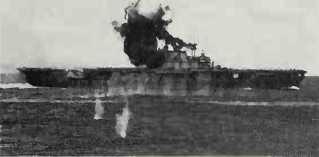C500 men under Capt William M’Whinnie, were trapped on Mos-tert’s Hoek ridge, about 5 miles (8km) northeast of Reddersberg, by cl,000 Boers with three Krupp guns. After a 24-hour bombardment, the waterless garrison surrendered (47 killed or wounded; 470 prisoners). RO’N.

Carrier uss Hornet afire at Santa Cruz
Santa Cruz, Battle of (October 26
1942). Naval battle fought by carrier aircraft off the Santa Cruz Islands, southwest Pacific. The Americans were defending Henderson Field, their foothold and air base on Guadalcanal. Both sides poured in reinforcements by sea and attempted to prevent the other doing so. The Japanese had an advanced force of one carrier, two battleships, five cruisers and 14 destroyers under Kondo, whilst the main force commanded by Nagumo had three carriers, two battleships, five cruisers and 15 destroyers. The US admirals, Kinkaid and Murray, had two carriers, one battleship, six cruisers and 12 destroyers, plus a further battleship with supporting ships having no direct part in the action. The Japanese hoped to recapture the airfield and fly in aircraft.
Initial contact was made and one American strike failed to find the enemy on October 25. The next day the Americans put carrier Zuiho out of action. Then, in simultaneous strikes which passed each other halfway, Japanese carrier Shokaku and uss Hornet were badly damaged, as was a cruiser on each side. Shortly afterwards, uss Enterprise was hit and Hornet further damaged — she had to be abandoned and was finally sunk by the Japanese. Although the Japanese drove the Americans off and inflicted more damage than they suffered, their success was marred by the loss of many irreplaceable aircrew, and they failed to take Henderson Field. CJWICD.
Sarajevo, Bosnia-Herzegovina.
Scene of the assassination on June 28 1914 of the heir to the Austro-Hungarian throne. Archduke Franz Ferdinand, precipitating World War I.
Saratoga. US aircraft carrier. Lexington class, converted from battlecruiser hull. Torpedoed January 1942 and missed Midway; torpedoed again at Guadalcanal; back in Solomons end of 1942; supporting Gilberts landings (1943). Marshalls, then operated with hms Illustrious in East Indies (1944); operating night fighters at Iwo Jima, damaged by bombing (1945). Expended at Bikini (1946).
Sarikamis, Battle of (December 29 1914-January 3 1915). Following Russia’s declaration of war on Turkey on November 4 1914, Enver Pasha, de facto Turkish c-in-c, ordered an offensive into the Caucasus. Some 95,000 men (Gen Achmet Izzet Pasha, under Enver’s direction) advanced from Erzurum; from Kars, a Russian army some
60,000-strong (nominally under Gen Mishlayevski; in fact commanded by his cos, Gen Yudenich) marched to meet the Turks at Sarikamis, 33 miles (53km) southwest of Kars, on December 29. Although reduced to c80,000 men in their two-week advance through icy mountain passes, the Turks attempted an envelopment: the Russians, operating on shorter supply lines, were able to reinforce and hold the frontal attack, while deep snow prevented the deployment of Turkish artillery in the planned flank attacks. The Russian counterattack forced the surrender of one Turkish corps and shattered another: after losing some 30,000 men in the five-day battle, the Turks retreated in disorder, only cl8,000 survivors reaching Erzurum. RO’N.
Sarrail, Gen Maurice (18561929). Fr. In an officer corps permeated with Catholic and monarchist sympathies, Sarrail, an infantryman who held strong Republican views, inevitably attracted attention. A supporter of Dreyfus in the 1890s, Sarrail subsequently served under the anticlerical Gen Andre in the French War Ministry and was Director of Infantry from 1907 to 1911. In
August 1914 he led the VI Corps at the Battle of Virton in the lower Ardennes before being appointed to replace the excitable Ruffey as commander of the Third Army at the end of the month. Sarrail’s resolute defence of Verdun in early September provided an anchor for the Allied left wing and contributed to the Marne victory. He was now a popular hero and Joffre, seeing him as a potential rival, used the Third Army’s reverses on the Argonne front in June-July 1915 as an excuse to remove him, thereby precipitating a political crisis. To placate his backers, Sarrail was given command of the French Army of the Orient sent to Salonika in October 1915. After consolidating their positions in Salonika, the Allied forces, under Sarrail’s overall command, moved up to the Serbian frontier, liberating Monastir in November 1916. However, the failure of his 1917 spring offensive increased unrest among his allies, already alienated by his high-handedness and political meddling. When Clemenceau became the French premier in November 1917, even Sarrail’s radical patrons at home could no longer shield him and he was relieved of command the following month. PJS.
Satellites. Satellites orbiting the Earth are used by both superpowers for military surveillance (including such tasks as photoreconnaissance, ocean surveillance, early warning, electronic intelligence-gathering and weather forecasting), communications and navigation. They play a vital part not only in military operations and planning but also as “national technical means of verification” for arms control. The American KH-11 reconnaissance satellite first launched in 1976 is almost 66ft (20m) long, weighs 29,7001b (13,500kg) and orbits at between 180 and 300 miles (300 and 500km) above the Earth for up to three years. It uses a powerful telescope and millions of picture elements recorded by “close-coupled devices” to receive electromagnetic radiation from the Earth by day and night. Daytime resolution is reportedly 8in (20cm). The data is then put into a digital and encrypted form for transmission to Earth. KH-11 can receive electro-




 World History
World History









